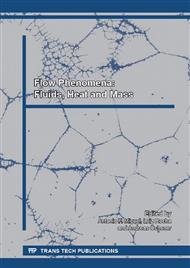p.118
p.126
p.135
p.144
p.151
p.157
p.166
p.182
p.192
Optimization of a Sensible Thermal Storage System by a Lumped Approach
Abstract:
This study is focused on the optimization of a sensible thermal storage system subjected to a cyclic energy source. The objective is to minimize the system heat storage mass and its geometry to guarantee its operation within an admissible temperature range. The storage medium is modeled as a Lumped system and the working fluid by a non-capacitive energy balance. The storage medium is composed of an array of parallel flat plates submitted to an air stream. The optimization is based on an exhaustive search method. It is observed that the minimum heat storage mass is proportional to the mass airflow rate. An optimal relationship between the superficial heat transfer rate and the fluid flow inertia, given by the dimensionless parameter NTU, is found to be constant (4.03) and independent in respect to the mass flow rate. The system time constant was invariable (3,230 s) for the optimal relationship between the interface heat transfer rate and the system inertia.
Info:
Periodical:
Pages:
182-191
Citation:
Online since:
April 2016
Price:
Сopyright:
© 2016 Trans Tech Publications Ltd. All Rights Reserved
Share:
Citation:


